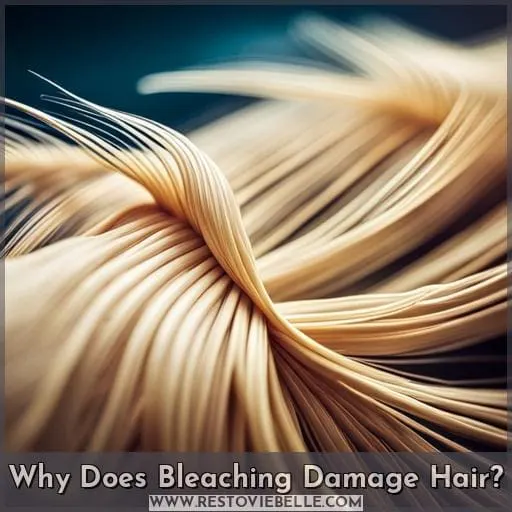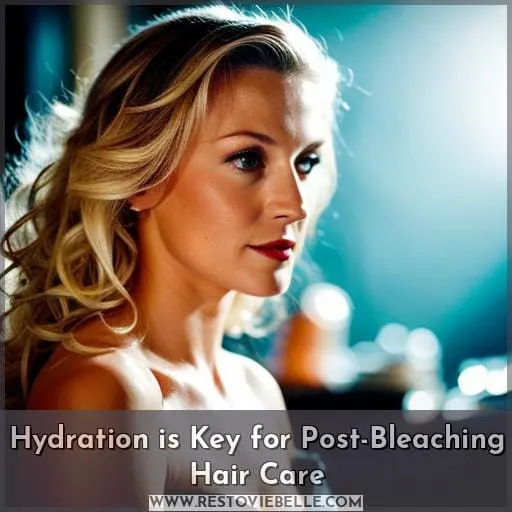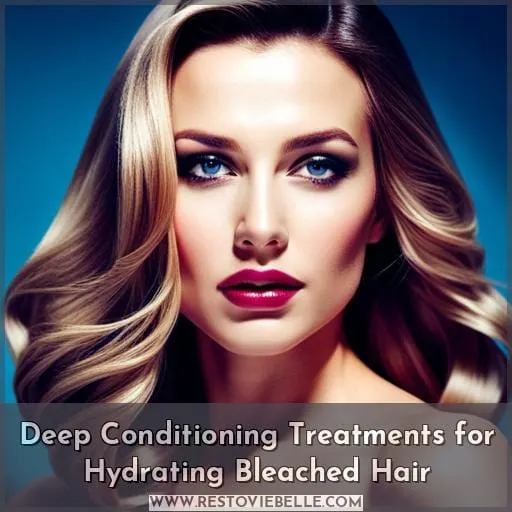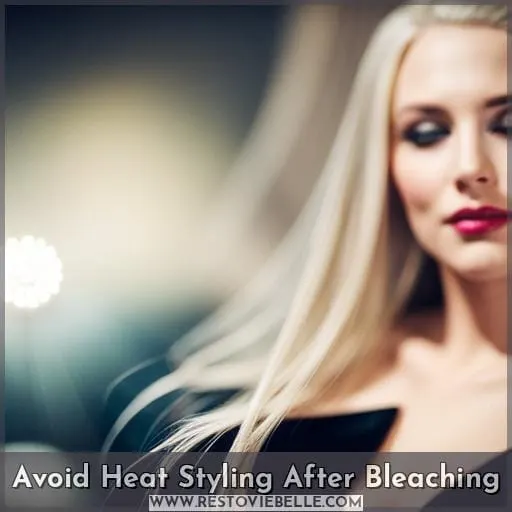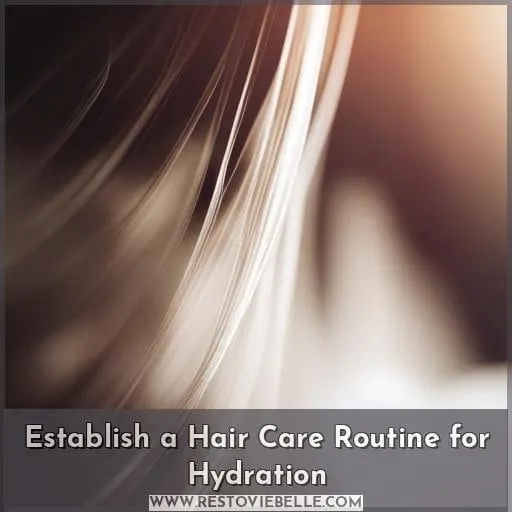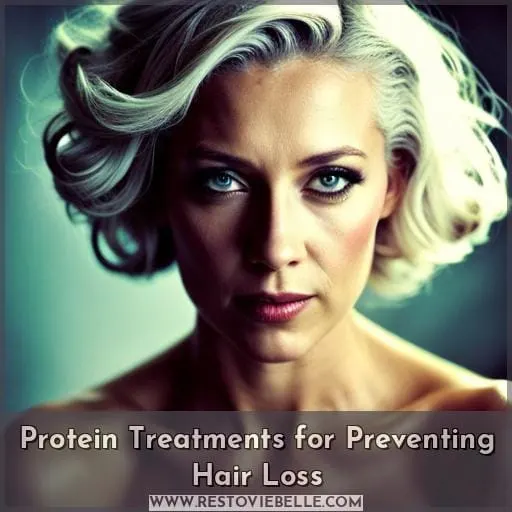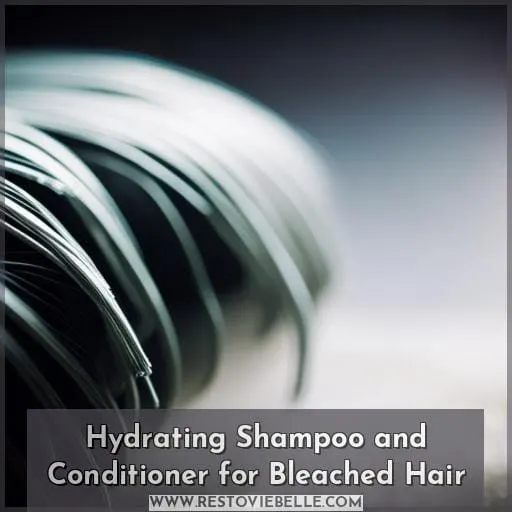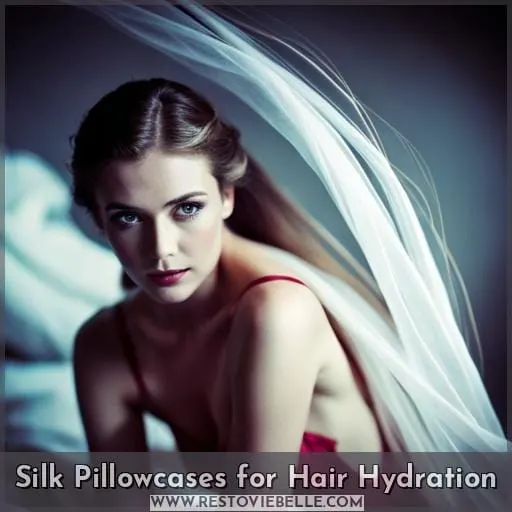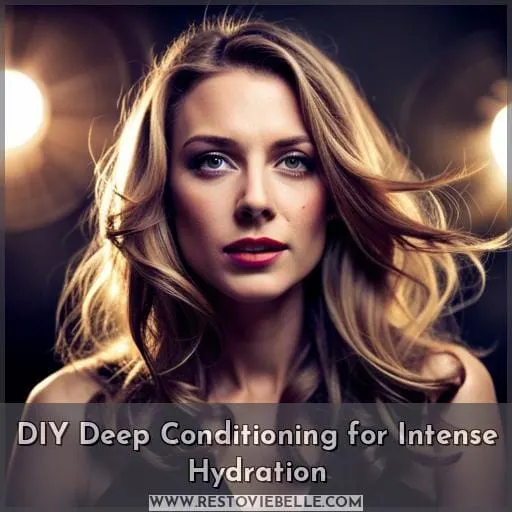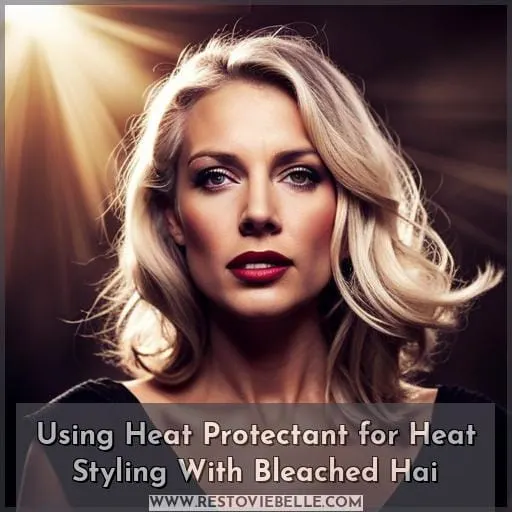This site is supported by our readers. We may earn a commission, at no cost to you, if you purchase through links.
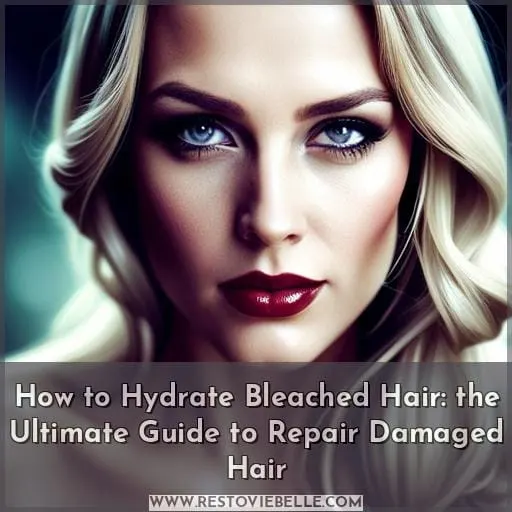 Bleached hair is dry and damaged, but you can restore its shine and strength with a hydrating hair care routine.
Bleached hair is dry and damaged, but you can restore its shine and strength with a hydrating hair care routine.
Table Of Contents
- Key Takeaways
- Why Does Bleaching Damage Hair?
- Hydration is Key for Post-Bleaching Hair Care
- Deep Conditioning Treatments for Hydrating Bleached Hair
- Avoid Heat Styling After Bleaching
- Establish a Hair Care Routine for Hydration
- Protein Treatments for Preventing Hair Loss
- Hydrating Shampoo and Conditioner for Bleached Hair
- Silk Pillowcases for Hair Hydration
- DIY Deep Conditioning for Intense Hydration
- Using Heat Protectant for Heat Styling With Bleached Hai
- Frequently Asked Questions (FAQs)
- Can I bleach my hair at home without damaging it?
- How long does it take for bleached hair to regain its moisture and hydration?
- Are there any natural remedies that can help hydrate bleached hair?
- Can I use regular shampoo and conditioner on my bleached hair?
- Is it necessary to use a heat protectant when heat styling bleached hair?
- Conclusion
Key Takeaways
- Bleaching opens cuticles and removes melanin, leading to porous and dry hair.
- Hydration is crucial in post-bleaching hair care to restore moisture and prevent breakage.
- Deep conditioning treatments such as hair masks and hair oils are effective in hydrating bleached hair.
- Establishing a consistent hair care routine, avoiding heat styling, and seeking professional guidance can help maintain optimal hydration for bleached hair.
Why Does Bleaching Damage Hair?
When you bleach your hair, you open up the cuticles to remove melanin, which can lead to hair damage due to the loss of natural oils.
The bleach breaks down the oils in your hair, leaving it porous and dry. This can cause your hair to become brittle and break easily.
Additionally, the bleach can damage the hair cuticles, which can lead to an uneven texture and make your hair more difficult to style.
Hydration is Key for Post-Bleaching Hair Care
Bleaching damages hair by stripping away its natural pigments and moisture. This can leave hair dry, brittle, and prone to breakage.
It’s important to restore moisture to your hair after bleaching to help repair damage and prevent further damage.
You can do this by:
- Using moisturizing shampoos and conditioners
- Applying hair masks
- Avoiding heat styling
The Importance of Moisture
As bleaching strips your hair of its natural pigments, it’s important to replace them with moisture.
This can be done through:
- Deep conditioning treatments.
- Using oils for hair hydration.
- Avoiding heat styling.
Cleanse and Condition for Hydration
To cleanse and condition your hair for hydration, you need to use:
- A gentle shampoo that won’t strip away natural oils.
- Avoid hot water and harsh combs.
- Use a leave-in conditioner and deep condition weekly.
Natural Remedies for Hydration
Once you’ve cleansed and conditioned your hair, you can use natural remedies to boost hydration.
- Apple cider vinegar
- Coconut oil
- Aloe vera
- Honey
- Egg yolk
Incorporate these ingredients into your hair care routine based on your hair porosity concerns and texture assessment for a weekly hair mask.
Deep Conditioning Treatments for Hydrating Bleached Hair
Deep conditioning treatments are an excellent way to hydrate bleached hair and repair damage. They work by penetrating the hair shaft and depositing moisture and nutrients, which can help to restore the hair’s natural elasticity and shine.
There are a variety of deep conditioning treatments available, including hair masks, hair oils, and deep conditioners.
Deep Conditioning Treatments
| Treatment | Benefits | Ingredients |
|---|---|---|
| Hair masks | Deeply hydrate the hair | Water, oils, butters, proteins, extracts |
| Hair oils | Seal in moisture and protect the hair from damage | Oils, butters, waxes |
| Deep conditioners | Hydrate and repair the hair | Water, oils, proteins, conditioners |
When choosing a deep conditioning treatment, it’s important to consider your hair type and needs. If your hair is dry and damaged, you may want to choose a treatment that contains a lot of moisture and protein.
If your hair is oily, you may want to choose a treatment that’s lighter on the oils.
Deep conditioning treatments should be used once or twice a week, depending on your hair type and needs. To use a deep conditioning treatment, apply it to your hair after shampooing and conditioning.
Deep conditioning treatments can help to improve the condition of your bleached hair, making it more hydrated, shiny, and manageable.
Avoid Heat Styling After Bleaching
Now that you’ve undergone the bleaching process, it’s important to avoid heat styling your hair to prevent further damage. Heat can be incredibly damaging to already fragile and bleached hair, leading to increased dryness, breakage, and overall weakening of the strands.
Here are three reasons why you should steer clear of heat styling after bleaching:
- Minimize Heat Damage: Excessive blow-drying or using curling irons, straighteners, or flat irons can subject your already vulnerable hair to intense heat which strips away moisture and weakens its structure.
- Prevent Hair Breakage: Bleached hair is more prone to breakage due to its weakened state. Applying high levels of heat through styling tools exacerbates this vulnerability and increases the risk of further damage.
- Preserve Hydration: The main goal after bleaching is rehydrating your locks as much as possible since bleach tends to strip away natural oils from the scalp and shafts alike. By avoiding excessive use of hot tools like blow dryers or straighteners post-bleach session helps maintain adequate moisture within each strand while preventing dehydration-induced brittleness.
By giving up on excessive heating methods in favor of air drying techniques or utilizing alternatives like cool settings on a dryer when necessary will help restore healthiness back into those precious tresses!
Establish a Hair Care Routine for Hydration
To establish a hair care routine for hydration after bleaching, it’s crucial to stick to a schedule and consult with a professional if needed.
By following a consistent routine, you can ensure that your hair receives the necessary moisture and nourishment it needs to repair damage caused by bleaching.
Additionally, seeking guidance from an experienced stylist or trichologist can provide valuable insights and personalized recommendations for effectively hydrating your bleached hair.
Stick to a Schedule
In addition to avoiding heat styling, sticking to a hair care schedule will help keep your bleached hair hydrated.
- Wash your hair every 3 days using lukewarm water instead of hot water, as it can strip away moisture.
- Avoid blow-drying your hair and opt for air drying or using gentle styling tools like wide-toothed combs or wet brushes to prevent breakage.
- Additionally, make sure to trim split ends regularly as they can hinder hydration and maintain a consistent routine with hydrating products suitable for your hair porosity and texture.
Consult a Professional for Assistance
For the best results in establishing a hair care routine for hydration, consult with a professional stylist.
- Find a stylist you trust.
- Ask about their experience with bleaching.
- Get a consultation and discuss your goals.
- Make sure you’re on the same page.
Protein Treatments for Preventing Hair Loss
Sticking to a hair care routine is important for hydration, and protein treatments can help prevent hair loss.
Protein is a key building block of hair, and when your hair is damaged, it can lose its natural protein. Protein treatments can help to restore the protein balance in your hair, which can lead to stronger, healthier hair.
There are a variety of protein treatments available, so you can find one that fits your hair type and budget. Some popular protein treatments include keratin treatments, hair masks, and leave-in conditioners.
You can also find protein-rich foods in your diet, such as eggs, fish, and beans.
In addition to protein treatments, there are a few other things you can do to prevent hair loss, such as:
- Trimming your hair regularly
- Avoiding heat styling tools
- Using a gentle shampoo and conditioner
Hydrating Shampoo and Conditioner for Bleached Hair
Bleaching your hair can strip it of its natural oils and leave it dry and brittle.
- Moisturizing shampoos and conditioners that are designed for bleached hair.
- Look for products that contain hydrating ingredients like aloe vera, coconut oil, or argan oil.
- You should also use a leave-in conditioner or pre-styling oil to help seal in moisture and protect your hair from heat styling.
When you’re washing your hair, use lukewarm water and avoid hot water, which can further dry out your hair.
If you’re using heat styling tools, be sure to apply a heat protectant spray to protect your hair from damage.
It’s also important to establish a regular hair care routine that includes deep conditioning treatments and trims to remove damaged hair.
Silk Pillowcases for Hair Hydration
To maintain the hydration of your bleached hair, consider investing in silk pillowcases. Silk is a natural fiber that’s smooth and hypoallergenic, making it ideal for hair that’s prone to dryness and damage.
Silk pillowcases can help to reduce friction and prevent frizz, which can help to retain moisture and promote shine. In addition, silk pillowcases can help to improve the overall health of your hair by creating a protective barrier against the elements.
Benefits of using silk pillowcases for hair hydration:
- Reduce friction and prevent frizz
- Retain moisture and promote shine
- Improve the overall health of your hair
- Create a protective barrier against the elements
DIY Deep Conditioning for Intense Hydration
Deep conditioning your hair with natural ingredients is an effective way to restore moisture and repair damaged hair after bleaching.
You can make your own deep conditioning treatment at home using ingredients like avocado, honey, egg whites, yogurt, rice water, apple cider vinegar, coconut oil, olive oil, argan oil, or marula oil. These ingredients are all rich in nutrients that can help to strengthen, repair, and hydrate your hair.
To make your own deep conditioning treatment, simply combine the ingredients you’ve chosen in a blender or food processor until they’re smooth and creamy. Then, apply the treatment to your hair and leave it on for 30 minutes to an hour.
Rinse it out thoroughly with warm water and follow with your regular shampoo and conditioner.
Deep conditioning treatments can be used once or twice a week, depending on the condition of your hair. If you have severely damaged hair, you may want to use a deep conditioning treatment more often.
Using Heat Protectant for Heat Styling With Bleached Hai
To protect your bleached hair from heat damage during styling, always use a high-quality heat protectant spray or cream. This crucial step will help maintain the moisture balance in your hair and prevent further dryness and breakage.
Here are some key points to consider when using a proper heat protectant:
- Choose the right product: Look for a heat protectant specifically formulated for color-treated or bleached hair. These products often contain ingredients that provide extra hydration and protection.
- Apply evenly: Make sure to distribute the product evenly throughout your damp or dry hair before using any heated styling tools.
- Use appropriate tools: Opt for low to medium temperatures on your heating devices, such as flat irons, curling wands, or blow dryers with diffusers. High temperatures can cause more damage to already fragile bleached strands.
- Reapply as needed: If you’re restyling your hair multiple times between washes, remember to reapply the heat protectant each time for continuous protection against thermal damage.
By following these guidelines and incorporating a high-quality heat protectant into your routine, you can minimize potential harm caused by frequent use of hot styling tools while keeping hydrated after bleaching.
Frequently Asked Questions (FAQs)
Can I bleach my hair at home without damaging it?
While it’s possible to bleach your hair at home, it carries a risk of damage. Professional assistance reduces the chances of adverse effects and ensures proper care for healthy, hydrated hair.
How long does it take for bleached hair to regain its moisture and hydration?
To regain moisture and hydration after bleaching, it typically takes several weeks of consistent care.
Implement a comprehensive hair care routine that includes:
- Hydrating products
- Regular trims to remove damaged ends
- Maintaining overall hair health through proper nutrition and lifestyle habits.
Are there any natural remedies that can help hydrate bleached hair?
To naturally hydrate bleached hair, try using avocado or coconut oil as a deep conditioning treatment.
These oils penetrate the hair shaft to replenish moisture and restore shine.
Apply, leave on for 30 minutes, then rinse thoroughly.
Can I use regular shampoo and conditioner on my bleached hair?
Yes, regular shampoo and conditioner may not provide enough hydration for bleached hair.
Opt for moisturizing products specifically designed to nourish and restore moisture to your hair after the bleaching process.
Is it necessary to use a heat protectant when heat styling bleached hair?
Shield your bleached locks by always using a heat protectant before styling.
This crucial step minimizes further damage, preserves moisture, and ensures your hair stays resilient.
Elevate your hair care routine with this simple yet potent defense.
Conclusion
To restore shine and strength to your bleached hair, it’s crucial to prioritize hydration.
By understanding why bleaching damages hair and incorporating a hydrating hair care routine, you can repair and revitalize your strands.
Deep conditioning treatments, avoiding heat styling, and using hydrating shampoos and conditioners are all effective methods for restoring moisture to your hair.
Additionally, incorporating natural remedies and protein treatments can help prevent hair loss and promote hydration.
With the right approach, you can achieve healthy, hydrated hair even after bleaching.

